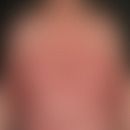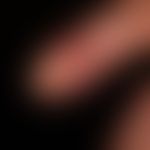Synonym(s)
HistoryThis section has been translated automatically.
Crocker 1888; Hallopeau 1889
DefinitionThis section has been translated automatically.
Eminently chronic, sterile, usually painful, pustular dermatitis of the finger (less commonly: toe) end-limbs, leading to skin and nail atrophy, with an exudative course lasting many years. May also lead to osteolytic changes of the acras.
You might also be interested in
EtiopathogenesisThis section has been translated automatically.
Unresolved; postulated to be a pustular variant of acral localized psoriasis pustulosa palmaris et plantaris. However, only a weak association with psoriasis is found in larger collectives. It can be hypothesized that development is influenced by a combination of environmental, genetic factors, and immune system abnormalities.
An association with HLA-B27 has been described.
Further associations exist with mutants of the IL-36RN gene, which are detected in acropustulosis, as in pustular psoriasis generalisata. IL36RN is a protein-coding gene that forms a cytokine gene cluster with 8 other genes of the interleukin-1 family on chromosome 2. Cytokines of this family play an essential role in epithelial barrier function as well as in inflammatory processes.
In the generalized forms of pustular psoriasis, there is dysregulation of IL-36-, Th17-, neutrophil-, and keratinocyte-driven inflammatory pathways. Serum and mRNA levels of the IL-17 cytokine family are significantly elevated in this patient clientele compared to patients with non-pustular disease. Because IL-17 are potent neutrophil chemotactic factors, their elevated levels are consistent with clinical pustularity.
Furthermore, mutations are detected in the AP1S3 gene (adaptor related protein-1 complex subunit delta1C), a gene encoding a subunit of adaptor protein complex 1 (AP-1). The detected mutations lead to autoreactive inflammation via overexpression of IL 36 (Setta-Kaffetzi N et al. 2014).
AP1S3 mutations are also detected in pustular psoriasis generalisata and in pustulosis palmoplantaris (Setta-Kaffetzi N et al. 2014).
ManifestationThis section has been translated automatically.
Age at first manifestation > 40 years. In very rare cases, the clinical picture has also been described in children.
LocalizationThis section has been translated automatically.
Dorsal sides and crests of the terminal phalanges of the fingers and/or toes. Usually severe involvement of the nail organ with complex nail dystrophy up to complete loss of the entire nail (scarring anonychia).
Less commonly, vesicles or pustules are observed on the soles of the feet or palms of the hands.
A transition into pustular psoriasis generalisata is not fundamentally excluded, but is the exception.
ClinicThis section has been translated automatically.
Mostly sharply proximally separated, red, painful, plaques with superficial, usually grouped, often confluent, 0.2-0.5 cm yellowish or whitish pustules. In addition, moist scales and scaly crusts. Pustules also frequently form subungually and at the nail folds. Such involvement results in onychodystrophy, which varies in severity depending on the acuity of the clinical symptoms.
About 20% of cases of acrodermatitis chronica suppurativa are accompanied by enthesitis/arthritis.
Also frequently associated is exfoliatio areata linguae.
The eminently chronic and relapsing course of the disease over many years is typical.
As the disease progresses, severe nail dystrophies, including loss of nails (scarring anoynchia) may occur; furthermore, acral bone atrophies, stiffening of distal finger end joints (DIP) are observed.
Remarks:
- The clinically groundbreaking pustelations may be absent (e.g., due to pretreatment), so that at initial diagnosis the clinical picture may be misjudged as chronic paronychia.
- The so-called parakeratosis Hjorth-Sabouraud can be described as a minus variant, which occurs mainly in children < 8 years of age.
HistologyThis section has been translated automatically.
Hyperkeratoses, acanthosis, unilocular, intraepithelial pustule with neutrophil leukocytes, spongiform degeneration of the epidermal cells in the peripheral area of the pustule.
External therapyThis section has been translated automatically.
In the acute phase of relapse glucocorticoids under occlusion. Suitable are 0.1% triamcinolone cream or halogenated glucocorticoids such as 0.05-0.1% betamethasone cream/ointment or mometasone furoate ointment (Ecural).
Glucocorticoid crystal suspensions injected intralesionally by Dermojet are indicated for very persistent lesions. Note: Injections are very painful due to localization!
In addition, astringent hand baths with tanning agents (e.g. Tannosynt liquid) can be performed.
Radiation therapyThis section has been translated automatically.
Internal therapyThis section has been translated automatically.
The disease is a classic indication for systemic therapy. There are currently no standardized guidelines for the treatment of acrodermatitis continua suppurativa, as the disease is rare and hardly responds to conventional external treatments. As a result, treatment experience is mostly based on individual case reports. Biological therapies now play a key role in the treatment of pustular psoriasis variants, including acrodermatitis continua suppurativa. The therapeutic approach must be individualized according to the patient's clinical features and comorbidities (Maliyar K et al. 2019). To date, there are individual case reports of the following successful therapies with:
- Acitretin:
- Adults: Initially 0.5 mg/kg bw neotigason/day, for 2-4 weeks, then increased to a maximum of 1 mg/kg bw/day depending on the effect. Maintenance dose: Usually 0.1-0.5 mg/kg bw/day for a further 6-8 weeks, possibly longer.
- Children: Very strict indication, careful risk-benefit assessment. Initial: 0.5 mg/kg bw/day. Maintenance dose: 0.1 mg/kg bw/day, under no circumstances > 0.2 mg/kg bw/day or > 35 mg/day.
Note! Systemic therapy should be combined with external treatment.
Alternative:
- Fumaric acid esters (e.g. Fumaderm): For severe courses, trial with increasing dosage e.g. Fumaderm initially 1 tbl/day in week 1 up to a maximum of 6 tbl/day Fumaderm in the 6th week.
- Methotrexate: Initially 10-15 mg/week p.o. or s.c. Depending on the response, the dose can be slowly reduced week by week. Maintenance dose: 2.5-5.0 mg/week.
- Ciclosporin A: reserve therapeutic agent! Initial: 2.5 mg/kg bw/day p.o., increase to 5 mg/kg bw possible, dose reduction according to skin findings, aim for the lowest possible maintenance dose.
- Biologics: The use of biologics is obvious. Numerous individual case reports in the literature identify cases (>50) of ACSH treated with biologics (Galluzzo M et al. 2019). Most case reports exist on TNF-α blockers. Unfortunately, these often lose efficacy over time, requiring comedications or dose increases to maintain efficacy. Treatment of acrodermatitis coninua suppurativa with etanercept, alone or in combination with other medications such as acitretin, has produced variably satisfactory results. A good response in ACH was reported for adalimumab; ustekinumab was also found to be effective, although in some cases the standard therapeutic dose first had to be doubled and could only be stabilized by the addition of acitretin. Even ustekinumab in combination with ciclosporin and prednisone did not lead to a cure in a highly resistant form of ACH. Secukinumab, a recombinant monoclonal human immunoglobulin G1κ antibody with a high affinity for the inflammatory mediator IL-17A, was also used successfully.
- Biologics in detail:
- Etanercept: S.a.u. psoriasis vulgaris. Standard dose (patients > 18 years): 2 times/week 25 mg s.c. Alternative: 2 times/week 50 mg s.c. for up to 12 weeks, then 2 times/week 25 mg s.c.
- Adalimumab: 40 mg s.c. every 4 weeks (standard dose)
- Ustekinumab: 45 mg s.c. every 12 weeks (standard dose)
Secukinumab: Good and sustained success has been achieved with the IL-17 inhibitor secukinumab (Galluzzo M et al. 2019; Schmid E et al. 2019)
- Further individual case reports exist on:
Brodalumab (Bardazzi F et al. 2020) IL-17 inhibitor
Guselkumab (Yamamoto H et al. 2023) IL23 inhibitor
Ixekizumab (Battista T et al. 2022) IL17 inhibitor
Bimekizumab (Cirone KD et al. 2023) IgG1 antibody
Case report(s)This section has been translated automatically.
1) A 43-year-old patient with severe, refractory acrodermatitis continua suppurativa on several fingers of both hands received adalimumab as off-label-use in a dosage of 40mg every 2 weeks for a total of 32 weeks after the use of multiple, not very successful topicals and only moderately successful systemic therapy with methotrexate (15mg/week p.o.) and ciclosporin A (3x100mg/day). Significant improvement thereunder. Except for the occasional appearance of "dyshidrotic vesicles" in the lesional area, the patient is free of symptoms.
2) A 72-year-old patient complained of painful erythema and edema on his right index finger for 2 years. There was erythema, edema, scaling, and 2-3 mm whitish pustules on the nail fold and fingertip; marked onychodystrophy. Family history was positive for psoriasis. Prior treatment included topical and systemic antibiotics with no clinical benefit. Laboratory tests, including microbiological examinations, were normal except for evidence of latent HBV infection. Histologic findings showed intraepidermal pustules. Sonographically, the small joints of the hands showed evidence of enthesitis. Based on the clinical and histologic features, a diagnosis of acrodermatitis continua suppurativa (Hallopeau) was made.
A 25-year-old man presented in August 2021 with acrodermatitis continua of Hallopeau on the distal phalanx of both thumbs, resulting in marked onychodystrophy with tenderness of the nails. An 8-year history of plaque psoriasis confined to the arms, axilla, groin, and gluteal cleft preceded. The rest of the history was negative. No medication history. No family history of exposure. Initial treatment was topical with calcipotriol and betamethasone dipropionate foam. Later supplementary systemic with acitretin and methotrexate (15mg/week/per os). The clinical effect was unsatisfactory. In July 2022, the patient started treatment with bimekizumab (320 mg every 4 weeks). He reported an excellent response. No UAWs. Both thumbnails had regrown normally after 2 months on this therapy (Cirone KD et al. 2023).
LiteratureThis section has been translated automatically.
- Ashurst PJC (1964) Relapsing pustular eruptions of the hands and feet. Brit J Derm 76: 169-180
- Balestri R et al (2018) Acrodermatitis continua of Hallopeau successfully treated with secukinumab. J Dermatolog Treat 29(sup1):3-5.
- Bardazzi F et al (2020) Brodalumab in the treatment of recalcitrant acrodermatitis continua of Hallopeau. Dermatol Ther 33:e14301.
- Battista T et al (2022) Acrodermatitis continua of Hallopeau successfully treated with ixekizumab: A case report. Dermatol Ther 35:e15383.
- Bhate C et al. (2022) Acrodermatitis continua of Hallopeau: historical perspectives and modern management. Ital J Dermatol Venerol 157:132-136.
- Buder V et al (2015) Successful therapy with adalimumab in acrodermatitis continua suppurativa. JDDG 13 (Suppl 1) 80
- Cirone KD et al (2023) Acrodermatitis continua of Hallopeau successfully treated with bimekizumab: A case report. SAGE Open Med Case Rep 11:2050313X231160937.
- Crocker HR (1888) Diseases of the skin. Lewis, London
- Galluzzo M et al (2019) Biologic therapy for acrodermatitis continua of Hallopeau: Successful treatment with secukinumab and review of the literature. Dermatol Ther 32:e12899.
- Hallopeau FH (1889) Sur une nouvelle forme de dermatite pustuleuse chronique en foyer à progression excentrique. Congr intern Derm Syph Compt rend, Paris: 344.
- Hallopeau M (1887) Sur un quatrié fait d'acrodermatite suppurative continuu. Ann Dermatol syphiligr 8: 1277-1281.
- Iijima S (2014) Case of acrodermatitis continua of Hallopeau following psoriasis with atypical clinical presentation. J Dermatol 41:1006-1008
- Maliyar K et al (2019) The Use of Biologic Therapy in the Treatment of Acrodermatitis Continua of Hallopeau: A Review. J Cutan Med Surg 23:428-435.
- Navarini AA et al (2017) European consensus statement on phenotypes of pustular psoriasis. J Eur Acad Dermatol Venereol 31(11): 1792-1799.
- Piraccini BM et al (1994) Hallopeaus acrodermatitis continua of the nail apparatus. Acta Derm Vener 74: 65-67.
- Ruggiero A et al. (2020) Etanercept for pediatric acrodermatitis continua of Hallopeau: A case report and literature review. Dermatol Ther 33:e14046.
- Sahin MT et al (2003) Acrodermatitis continua of Hallopeau: was it an outcome of a surgical trauma or initially misdiagnosed as onychomycosis? J Eur Acad Dermatol Venereol 17: 236-238
- Schmid E et al (2019) Two cases of acrodermatitis continua suppurativa (Hallopeau's disease) treated with IL-17A inhibitors. J Dtsch Dermatol Ges 17:643-645.
- Setta-Kaffetzi N et al (2014) AP1S3 mutations are associated with pustular psoriasis and impaired Toll-like receptor 3 trafficking. Am J Hum Genet 94: 790-797.
- Török L et al (2003) Pemphigus vegetans presenting as acrodermatitis continua suppurativa. Eur J Dermatol 13:579-581.
- Weisshaar E et al (2007) Successful etanercept therapy in therapy refractory acodermatitis continua suppurativa Hallopeau. J Dtsch Der matol Ges 5:489-492.
- Wilsmann-Theis D et al (2004) Successful treatment of acrodermatitis continua suppurativa with topical tacrolimus 0.1% ointment. Br J Dermatol 150:1194-1197.
- Yamamoto H et al (2023) A case of acrodermatitis continua of Hallopeau evolving into generalized pustular psoriasis successfully treated with guselkumab. Int J Dermatol 62:269-270.
Incoming links (29)
Acral granulomatous dermatosis; Acrodermatitis enteropathica; Acrodermatitis perstans; Acropustuloses; Anonychie acquired; Ap1s3 gene; Candida paronychia; Dermatitis, infectious eczematoid; Dermatitis repens; Hallopeau, francois henri; ... Show allOutgoing links (31)
Acanthosis; Acitretin; Adaptor protein complexes; Anonychia (overview); Betamethasone; Bimekizumab; Brodalumab; Calcipotriol; Ciclosporin a; Ciclosporin a; ... Show allDisclaimer
Please ask your physician for a reliable diagnosis. This website is only meant as a reference.



























